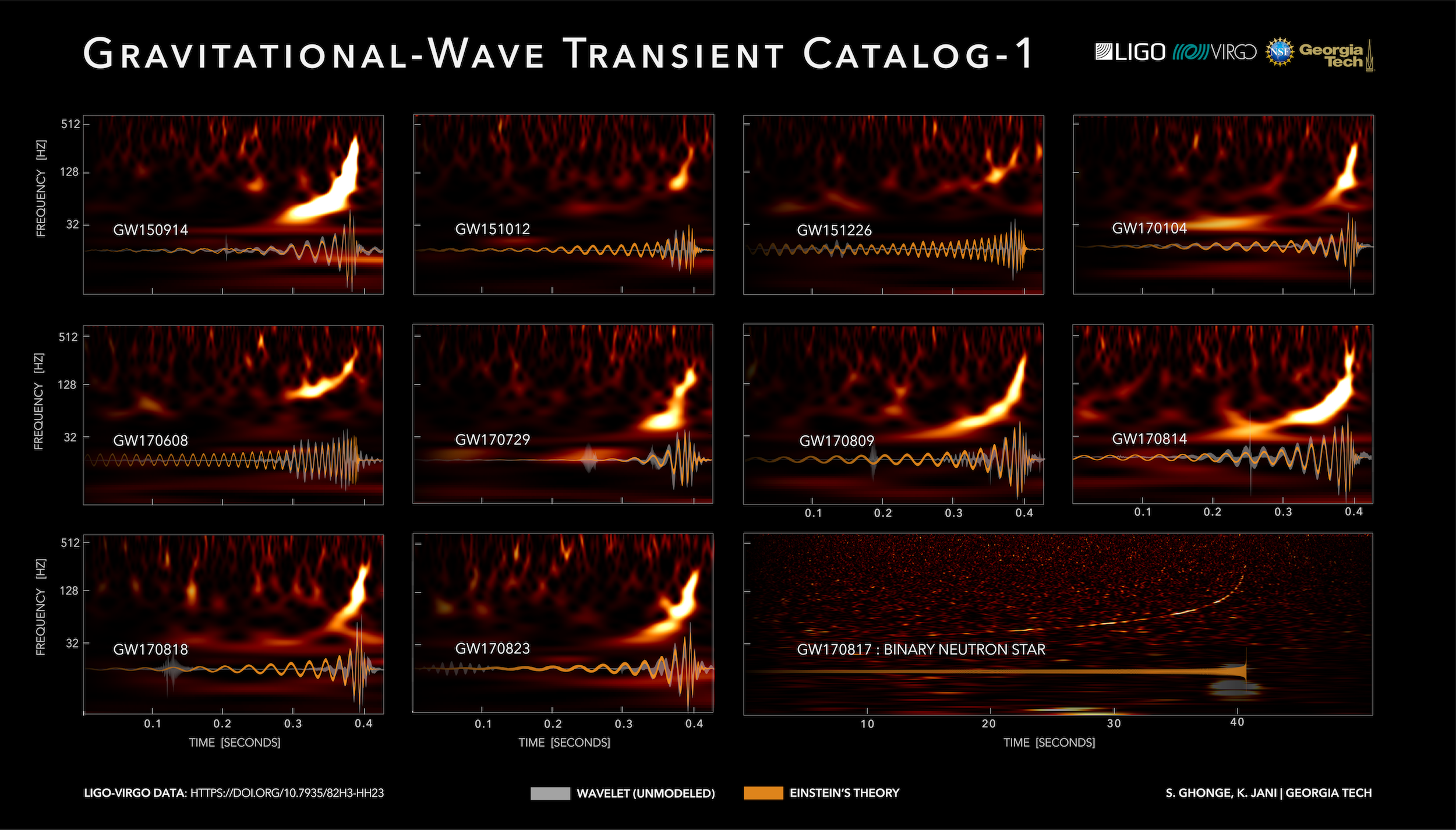PhD Research
A Model-independent Search for Anisotropies
in Stochastic Gravitational-wave Backgrounds
I led the algorithmic development in mapping anisotropies in Stochastic Gravitational-wave Backgrounds (SGWBs) using the LIGO-Virgo folded datasets. We provide a model-independent estimate of the intensity of the SGWB signal and its anisotropies in the pixel domain, complimentary to LIGO-Virgo’s results in the Fourier domain. We project cross-correlated data onto sky pixels using time-dependent directional sensitivities of LIGO-Virgo detector combinations. We then weigh the projection by pixel domain noise covariance to obtain SGWB maps similar to that of the Cosmic Microwave Background.
Using publicly available LIGO-Virgo folded datasets, our search is computationally cheap. By further employing efficient parallel processing techniques, we are able to cast time-segment radiometer analysis into a matrix multiplication problem. We provide the optimal spectral decomposition of the SGWB signal by adaptively dividing the analysis into distinct frequency bands. We also investigate better regularization techniques of inverting full Fisher information matrices for incorporating pixel-pixel correlations in anticipation of future detector network sensitivity improvement.
[Paper: https://journals.aps.org/prd/abstract/10.1103/PhysRevD.107.122002] Back to top
The PyCBC Search Pipeline for Gravitational-wave Detection
I work on the development and operation of one of LIGO-Virgo's discovery pipelines - the PyCBC pipeline for gravitational waves (GWs) from compact binary coalescences (CBCs). The goal of PyCBC is to identify candidate GW signals in the LIGO-Virgo data and to provide statistical significance of GW candidates. Detecting GWs in a stream of noisy data is challenging, since the amplitude of GW signals is comparable to that of the noise background, if not lower. We thus implement various signal processing techniques. At its core, PyCBC performs a frequency-domain matched-filtering search for GWs from CBCs using a bank of gravitaional-waveform templates distributed in a chosen parameter space.
With GWs from CBCs being well-modeled, matched filtering is the optimal search method. If detector data are stationary and Gaussian, the matched-filter signal-to-noise ratio (SNR) would suffice as a detection statistic. However, detector data are in no way stationary or Gaussian. Advanced techniques are required to eliminate or mitigate noise transients. Additional to SNR, we implement two more chi-squared statistics to battle loud noise transients, which essentially compute the signal power in some time-frequency regions and evaluate its likelihood of being a GW signal. SNR is then re-weighted by these chi-squared statistics. For each detector, we only keep triggers with re-weighted SNRs above a certain threshold, which constitute our single detector triggers.

To claim confident detections, a coincidence test is performed once single detector triggers are ready. We combine re-weighted SNRs from all detectors to obtain a network SNR. This network SNR is further re-weighted using a probability distribution map of signal vs. noise over time delay, phase and amplitude, calculated aforehand. This final statistic is what we use as the detection statistic. To obtain statistical significance, false-alarm rates, of GW candidates, we apply a huge amount of time-shifts larger than the time-coincidence window to the data to generate background data that are physically impossible to contain real GWs. We compare detection statistics of candidate events to the time-shifted data and obtain false-alarm rates of GW candidates. The false-alarm rate statistic asks the question: "How likely is it to obtain a false positive with a detection statistic as loud as the GW candidate in question?"
I work on improving the detection statistic by combining information about signal coherence and noise incoherence in different detectors, as well as lowering noise background estimation by gating out loud instrumental glitches. As a whole, the PyCBC team is actively researching novel ways to boost signal significance and alleviate noise as much as possible. PyCBC has an online version and an offline version. During observing runs, we operate, monitor and maintain the online version to provide low-latency GW candidate alerts to the electromagnetic (EM) wave astronomy community for rapid EM follow-ups. We also operate PyCBC offline during observing runs for more in-depth searches to recover more GW events and to provide more precise science statements about the candidates.

[PyCBC website: https://pycbc.org] Back to top
Bilby: A Modular Bayesian Inference Library for GW Science
Bayesian inference is essential in studying GW science. Once GW detections have been made, we apply Bayesian inference to extract source parameters (parameter estimation). And this, in turn, enables us to study astrophysical properties of individual sources of GWs. We also use Bayesian inference to decide between models (model selection), such as selecting between a model with precessing spins and one with aligned spins for a compact binary system. In addition, Bayesian inference is a tool to extract hyper-parameters of population properties (hierarchical Bayesian inference).
Bilby is a Bayesian inference library designed for GW science that also goes beyond it. I am a developer of Bilby and have utilized Bilby to successfully reproduce LIGO's previously published GWTC-1 events. I have rewritten the module of prior probability distributions in Bilby for a computation speedup of 2-fold to 1000-fold.

[Bilby website: https://lscsoft.docs.ligo.org/bilby/] Back to top